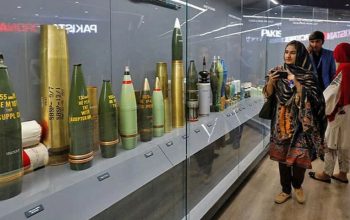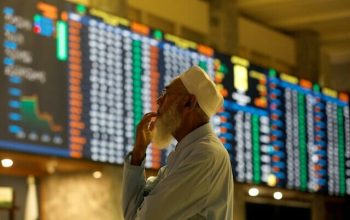Gatron (Industries) Limited (PSX: GATI) was incorporated in Pakistan as a public limited company in 1980. The company is engaged in the manufacturing of Polyester Filament Yarn through its self produced Polyester Polymer/Chips. Besides, the company also produces PET Preforms, PET Resins, PET Bottle, BOPET film, PET sheet, fashion apparel, Home Textile etc. The company belongs to Gani & Tayub Group (G&T).
Pattern of Shareholding

As of June 30, 2022, GATI has a total of 38.364 million shares outstanding which are held by 1258 shareholders. Local General Public is the largest shareholder of GATI with a stake of 40.74 percent in the company. This is followed by Directors, CEO, their spouse and minor children holding 25.25 percent shares of the company. Banks, DFIs and NBFIs account for 16.35 percent shares of GATI while associated companies, undertakings and related parties hold 4.22 percent shares. About 1.79 percent of GATI’s shares are owned by foreign public. The remaining shares are held by other categories of shareholders.
Historical Performance (2018-22)

Except for a plunge in 2020, GATI’s topline and bottomline have been growing sanguinely in all the years under consideration. Gross margin of GATI which had been inching down until 2020 posted a rebound thereafter to boast its optimum level in 2022. Conversely, operating margin and net margin grew until 2019 and nosedived in 2020. Operating margin took an upward flight since 2021 and reached its peak in 2022. On contrary, net margin shriveled in 2021 too. Although it rebounded in 2022 but couldn’t gain much momentum – thanks to a continuous upsurge in gearing ratio and high discount rate. The detailed performance review of each of the years under consideration is given below.

In 2019, GATI’s topline grew by 36 percent year-on-year on the back of a 26 percent rise in the sales volume coupled with an upward revision in the prices of Polyester Filament Yarn (PFY). The price revision was in line with an increase in the prices of raw materials as well as Pak Rupee depreciation. Cost of sales grew by 37 percent year-on-year, resulting in a 33 percent year-on-year growth in gross profit while GP margin ticked down from 9.6 percent in 2018 to 9.4 percent in 2019. Distribution expense sank by 3 percent year-on-year in 2019 despite higher sales volume on account of low advertisement and promotion budget and low handling, freight and transportation charges incurred during the year. Administrative expense rose by 10 percent year-on-year in 2019 due to higher payroll expense as the company enhanced the production capacity of PFY from 29,074 MT in 2018 to 32,502 MT in 2019. Other expense posted a 21 percent year-on-year spike in 2019 due to hefty exchange loss, higher provisioning for WPPF and greater loss incurred on scrapped items of property, plant and equipment. Other income also slumped by 30 percent year-on-year due to high base effect created by the gain on the disposal of property, plant and equipment in 2019. Despite higher expenses, robust revenue stream saved the day for the operating profit of GATI which grew by 53 percent year-on-year in 2019 with OP margin also progressing from 5 percent in 2018 to 5.7 percent in 2019. Finance cost grew by 21 percent year-on-year in 2019 on the back of high discount rate as well as increased long-term and short-term borrowings obtained during the year for the purchase of fixed assets and for working capital requirements respectively. Gearing ratio grew from 11 percent in 2018 to 15 percent in 2019. What proved to be the game changer for GATI’s bottomline in 2019 was a staggering 146 percent year-on-year rise in investment income which clocked in at Rs.1120.09 million. Investment income comprised of dividend income from a subsidiary company, Messrs Gatro Power (Private) Limited and from an associated company, Messrs Novatex Limited. Massive investment income not only drove the bottomline up by 83 percent year-on-year in 2019 to clock in at Rs.1794.74 million but also resulted in a sizeable rise in NP margin from 7.5 percent in 2018 to 10.1 percent in 2019. It should also be noted that the investment income also resulted in a higher NP margin than GP margin and OP margin in 2019. EPS grew from Rs.25.59 in 2018 to Rs.46.78 in 2019.

In 2020, the effect of COVID-19 came to play resulting in a 27 percent year-on-year drop in GATI’s topline. The revenue compression was the result of a 30 percent decline in the sales volume of PFY, firstly because of extreme dumping and imposition of 17 percent sales tax on textile vis-à-vis zero rating earlier and then because of the outbreak of COVID-19. Cost of sales also slid by 25 percent year-on-year in 2020 due to 66 days of no production on account of lockdown imposed during the year. Gross profit inched down by 43 percent year-on-year with GP margin marching down to 7.3 percent due to higher per unit fixed overhead cost on account of low capacity utilization. Just before COVID-19, the company also enhanced the production capacity of PFY to 36,974 MT but it also stayed idle due to lockdown.8 percent drop in distribution expense in 2020 is a no brainer given depressed sales volume. Administrative expense, however, grew by 13 percent year-on-year in 2020 due to higher payroll expense in line with inflation while the number of employees plummeted from 778 in 2019 to 772 in 2020. Other expense slipped by 49 percent year-on-year in 2020 due to lower provisioning against WWF and WPPF and also because of lower magnitude of exchange loss. Other income posted a tremendous rise of 548 percent year-on-year in 2020 due to a massive rise in the gain on disposal of property, plant and equipment. Operating profit tapered off by 55 percent year-on-year in 2020 with OP margin sliding down to 3.5 percent. During 2020, GATI’s finance cost rose by 1083 percent year-on-year on account of massive spike in borrowings to undertake capital expenditure and also for working capital requirements. This pushed GATI’s gearing ratio up from 15 percent in 2019 to 34 percent in 2020. However, an 8 percent growth in investment income due to considerably high dividend income from Messrs Novatex Limited diluted the impact of high finance cost on the bottomline. GATI’s bottomline sank by 41 percent year-on-year in 2020 to clock in at Rs.1060.63 million with an NP margin of 8.2 percent. EPS settled down to Rs.27.65 in 2020.

GATI’s net sales once again took an upward flight in 2021 with a 28 percent year-on-year growth in topline due to increase in the sales volume of both PFY and PET performs during the year. The capacity utilization of PFY unit stood at 82 percent in 2021 which was still lower than the capacity utilization of over 95 percent before 2014 due to high quantity of imported yarn in the market. Cost of sales grew by a lower magnitude of 22 percent year-on-year in 2021 on account of reduction in energy cost as GIDC was removed a per the directives of the Supreme Court of Pakistan. This resulted in a 98 percent rise in gross profit with GP margin climbing up to 11.3 percent in 2021. Distribution expense grew by 22 percent year-on-year in 2021 due to rise in freight and transportation charges and higher sales volume. Administrative expense tumbled by 3 percent year-on-year in 2021. Other expense spiraled by 52 percent year-on-year in 2021 due to higher provisioning against WWF and WPPF and also because of impairment and write offs of fixed assets during the year. Other income built up by 39 percent year-on-year in 2021 due to reversal of provision for GIDC and re-measurement gain on the discounting of provision for GIDC. Operating profit mounted by 192 percent year-on-year in 2021 with OP margin rising up to 7.9 percent. Finance cost contracted by 38 percent year-on-year in 2021 due to monetary easing. This was despite an increase in borrowings which drove the gearing ratio up to 52 percent in 2021. Investment income fell by 91 percent year-on-year in 2021 as the company received no dividend income from Messrs Novatex Limited during the year. Lower investment income culminated into net profit rising by only 0.5 percent in 2021 with NP margin sinking to 6.4 percent – the lowest among all the years under consideration. EPS marginally grew to Rs.27.78 in 2021.

In 2022, GATI’s topline posted the highest year-on-year growth of 45 percent year-on-year on account of higher quantum of sales of PFY coupled with high prices. During the year, the company increased its production capacity to 75000 MT. Utilized 76 percent of its installed capacity. Cost of sales grew by 41 percent year-on-year on account of increase in commodity prices and Pak Rupee depreciation. However, higher off-take and better pricing resulted in a 70 percent year-on-year rise in gross profit with GP margin climbing up to 13.3 percent in 2022. Distribution expense grew by 42 percent on account of higher sales volume which drove up the handling, freight and transportation charges. Administrative expense also grew by 23 percent year-on-year as higher installed capacity required more human resource induction. Employee headcount grew from 769 in 2021 to 832 in 2022, translating into a higher payroll expense. Other expense posted a year-on-year growth of 39 percent in 2022 due to higher provisioning against WPPF, higher impairment for long-term investment and slow moving stores and spares as well as higher exchange loss. However, this was offset by a 211 percent growth in other income which was the result of gain on disposal of property, plant and equipment. Operating profit grew by 101 percent in 2022 with OP margin hiking to 11 percent. Finance cost grew by 146 percent year-on-year in 2022 due to high discount rate as well as increased borrowings which took the gearing ratio to 58 percent. However, investment income came to the rescue with a 100 percent year-on-year growth in 2022 on account of higher dividend income from Messrs Gatro Power (Private) Limited. Bottomline grew by 71 percent year-on-year in 2022 to clock in at Rs.1827.24 million with an NP margin of 7.6 percent. This was despite the imposition of super tax in 2022. EPS mounted to Rs.47.63 in 2022.

Recent Performance (9MFY23)

During 9MFY23, net sales grew by 19 percent year-on-year, however, it couldn’t trickle down to produce a healthier bottomline. During 9MFY23, GATI recorded a net loss of Rs.124.05 million with a loss per share of Rs.3.23 as against the net profit of Rs.1894.46 million and an EPS of 49.38 during the same period last year. The main reason for the lackluster performance was low sales volume due to dumping by Chinese PFY producers, slow supply of raw materials from Messrs. Lotte and also because of shortage of gas. Consequently, the company could not utilize 70 percent of its installed capacity during 9MFY23. The topline growth was merely the result of price revisions while sales volume remained depressed during the period. Furthermore, high cost of sales due to Pak Rupee depreciation, higher commodity prices as well as energy prices pushed the gross profit down by 64 percent year-on-year in 9MFY23 with a GP margin of 4.8 percent versus 15.6 percent in 9MFY22. Distribution and administrative expense rose by 44 percent and 51 percent respectively in 9MFY23 on account of high inflation. While other expense remained constant over the year, other income slid by 63 percent during 9MFY23. This resulted in a 90 percent compression in operating profit with OP margin sliding down to 1.1 percent in 9MFY23 from 13.6 percent during the same period last year. Finance cost grew by 332 percent during the period on account of high discount rate and higher long-term borrowings. While investment income also grew by 200 percent during 9MFY23, it couldn’t offset the finance cost and resulted into net loss during the period.
Future Outlook
The future performance of GATI is contingent upon how effectively the dumping of Chinese PFY is controlled by imposing and collecting anti dumping duties on the importers. This will not only benefit the local producers but will also take the indigenous PFY production to a level which will meet the local demand and create import substitution. This will be a good omen amidst precarious state of foreign exchange reserves of the country.
While the market share of GATI and its cost element highly depend on the external circumstances, what GATI can do right now to build up its margins and bottomline is to undertake efficient capital risk management and scale down its gearing ratio which has been growing unabatedly, culminating into mounting financial cost.
Read the full story at the Business Recorder - Latest News website.



